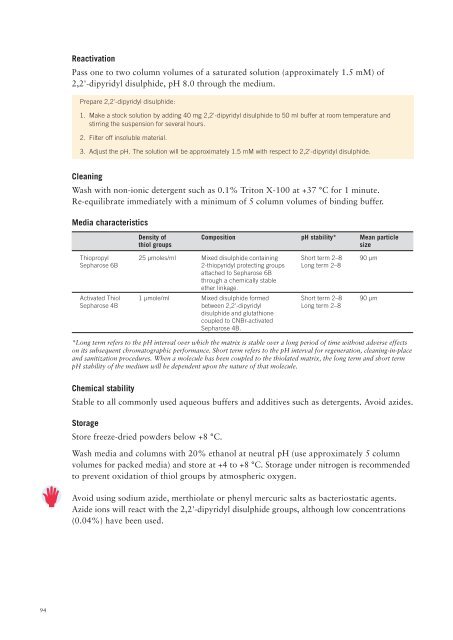Affinity Chromatography - Department of Molecular and Cellular ...
Affinity Chromatography - Department of Molecular and Cellular ...
Affinity Chromatography - Department of Molecular and Cellular ...
Create successful ePaper yourself
Turn your PDF publications into a flip-book with our unique Google optimized e-Paper software.
Reactivation<br />
Pass one to two column volumes <strong>of</strong> a saturated solution (approximately 1.5 mM) <strong>of</strong><br />
2,2'-dipyridyl disulphide, pH 8.0 through the medium.<br />
Prepare 2,2'-dipyridyl disulphide:<br />
1. Make a stock solution by adding 40 mg 2,2'-dipyridyl disulphide to 50 ml buffer at room temperature <strong>and</strong><br />
stirring the suspension for several hours.<br />
2. Filter <strong>of</strong>f insoluble material.<br />
3. Adjust the pH. The solution will be approximately 1.5 mM with respect to 2,2'-dipyridyl disulphide.<br />
Cleaning<br />
Wash with non-ionic detergent such as 0.1% Triton X-100 at +37 °C for 1 minute.<br />
Re-equilibrate immediately with a minimum <strong>of</strong> 5 column volumes <strong>of</strong> binding buffer.<br />
Media characteristics<br />
Density <strong>of</strong> Composition pH stability* Mean particle<br />
thiol groups<br />
size<br />
Thiopropyl 25 µmoles/ml Mixed disulphide containing Short term 2–8 90 µm<br />
Sepharose 6B 2-thiopyridyl protecting groups Long term 2–8<br />
attached to Sepharose 6B<br />
through a chemically stable<br />
ether linkage.<br />
Activated Thiol 1 µmole/ml Mixed disulphide formed Short term 2–8 90 µm<br />
Sepharose 4B between 2,2'-dipyridyl Long term 2–8<br />
disulphide <strong>and</strong> glutathione<br />
coupled to CNBr-activated<br />
Sepharose 4B.<br />
*Long term refers to the pH interval over which the matrix is stable over a long period <strong>of</strong> time without adverse effects<br />
on its subsequent chromatographic performance. Short term refers to the pH interval for regeneration, cleaning-in-place<br />
<strong>and</strong> sanitization procedures. When a molecule has been coupled to the thiolated matrix, the long term <strong>and</strong> short term<br />
pH stability <strong>of</strong> the medium will be dependent upon the nature <strong>of</strong> that molecule.<br />
Chemical stability<br />
Stable to all commonly used aqueous buffers <strong>and</strong> additives such as detergents. Avoid azides.<br />
Storage<br />
Store freeze-dried powders below +8 °C.<br />
Wash media <strong>and</strong> columns with 20% ethanol at neutral pH (use approximately 5 column<br />
volumes for packed media) <strong>and</strong> store at +4 to +8 °C. Storage under nitrogen is recommended<br />
to prevent oxidation <strong>of</strong> thiol groups by atmospheric oxygen.<br />
Avoid using sodium azide, merthiolate or phenyl mercuric salts as bacteriostatic agents.<br />
Azide ions will react with the 2,2'-dipyridyl disulphide groups, although low concentrations<br />
(0.04%) have been used.<br />
94
















